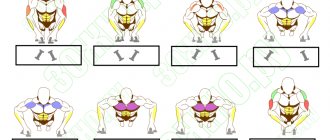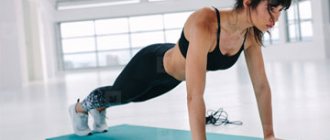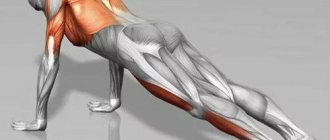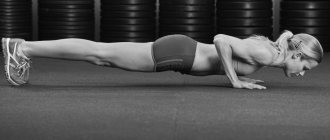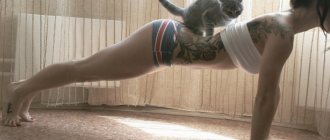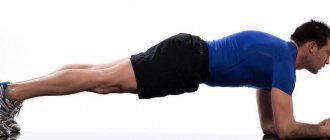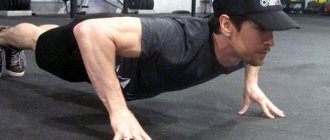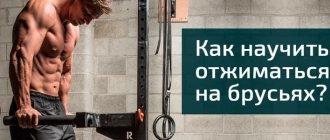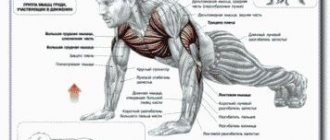The simple push-up is the best basic exercise that can benefit any athlete from any sport. You can do them anywhere, without using any projectiles. “You will always have a floor,” said Steve House, creator of the alpine athletics training program. Push-ups work the chest, shoulders and triceps, as well as the torso, legs and back. This is a lot for such a simple exercise, but if you have the wrong technique, then the benefits of the exercises are greatly reduced.
To learn how to do push-ups correctly, you need to master the correct plank. Your arms should be fully extended, with your arms, elbows and shoulders in a straight line. There should be no more than 30 cm between your feet, and the closer they are to each other, the more difficult the push-ups are because you need more core stability. As the exercise progresses (unless variation changes it), your spine should be neutral so that your body forms a straight line from your heels to your head. Remember to engage your core and hip muscles to keep your hips in that straight line.
You can bend your elbows at right angles to create a T shape, which tightens your pectoral muscles, or you can tuck your elbows toward your sides to put more pressure on your triceps, says Jared Wagy, doctor of physical therapy and a certified strength training specialist. You need to lift your entire body and excess weight will hinder you. For functional movement, you're unlikely to need pumped pecs, but triceps are useful in life - think skiing, maintaining balance when walking on uneven ground, or rock climbing. Elbows are also a fairly sensitive part of the body, especially in people with weak joints, so toned muscles can take on some of the work.
To prevent shoulder injury, Vagi advises you to lower your chest just below the line between your bent elbows so that your forearms are parallel to the ground. If you go lower, the shoulder joint will experience extra stress.
Regarding speed, there is no reason to perform this exercise quickly. Proper technique is much more important than speed. Always move slowly and in a controlled manner. Make this exercise meditative, focus on breathing: inhale as you lower and exhale as you push off the floor.
Benefits of push-ups
This exercise is a basic one - when several muscle groups are involved at once:
- breast;
- shoulder girdle;
- arms (biceps and triceps);
- abdominal muscles.
During push-ups, it is possible to shift the emphasis to those muscle groups that you want to use (triceps, shoulders, chest - read on about this) - in order to emphasize the load, you need to redistribute the load.
The peculiarity of push-ups is that muscle activation occurs immediately after taking the starting position. Regular push-ups help build strength and increase endurance. Some other benefits of push-ups should be noted:
- the respiratory and circulatory systems are strengthened;
- metabolic processes improve;
- The body's immune strength increases.
Thanks to regular training, even at home, muscle tone significantly increases and muscle mass increases. Not every exercise can boast such results. The undoubted advantage of push-ups is:
- the possibility of their implementation in childhood
- no special equipment required
What else will help you pump up?
If you think that with push-ups alone you will build yourself a beautiful body, you, unfortunately, are mistaken.
With push-ups you can develop, first of all, the chest and triceps. The shoulders are partially worked, the forearms, wrists, and core muscles are involved.
But you can feel growth only in those muscles that bear the main load. Pump up your triceps - yes. Breasts too, yes. Shoulders - and even them can be pumped up in this way, although only the front bundles.
What about the legs, biceps, back? They won't change. To get pumped up, you need to train your whole body. Especially the legs. Without training your legs, you will not actively gain weight.
The principle here is simple - the heaviest load is usually placed on the legs, due to which more anabolic hormones are produced. As a result, overall muscle mass grows faster.
Nutrition and sleep
You can pump up muscles if you get the right amount of proteins, fats and carbohydrates into your body. Without adequate nutrition, there is no weight gain.
In addition, it is necessary that everything eaten is well absorbed. To do this, meals should be small and frequent. If you eat twice a day and take your main meal before bed, hoping to gain muscle mass is absurd.
As for sleep, it is no secret that the body needs to rest a certain number of hours a day. All recovery processes take place during sleep, including in mice. Without this, their growth is impossible. Without enough sleep, you will quickly become overtrained.
Bottom line - to gain muscle mass you need a complex consisting of nutrition, sleep and training. Then you can develop your body with push-ups. How to pump up if at least one of these components is insufficient? Alas, no way.
Where to start training push-ups
Despite the apparent simplicity of the push-up technique, it is still worth considering a number of nuances:
- Exercise in moderation. Avoid excessive stress, especially in the first lessons. In this case, it is quality that matters most.
- Don't rush to get results quickly. Push-up training should gradually become more difficult, and preparation for the next level of load can last several weeks. As soon as the muscles are sufficiently strong and the required number of push-ups is easy, then you can increase the load.
- Follow breathing technique. This plays an important role. Incorrect breathing technique can disrupt the entire training process.
Progression of the pectoral muscles: a real-life example
The person I gave as an example, working out simply out of boredom, was able to pump up his pectoral muscles to some extent. I must say that before training they were not visible at all. The asthenic chest was flat, like an ironing board.
Training in the hospital
A man was hospitalized due to inflammation of the digestive tract.
The first couple of days he came to his senses after prolonged abdominal pain. As soon as his condition improved, he became bored of just lying there and doing nothing. Oh yes, we are talking about a guy who is 17 years old.
The patient was lying alone in the ward. You know what the beds in hospitals are like. No, not in modern private wards, where everything was done according to different drawings a long time ago. A regular bed with a removable headrest.
Out of boredom and already feeling well at that time, the man decided to train - in a hospital setting he could pump up his abs and do push-ups. He began doing push-ups on the floor.
General recommendations
To ensure the most effective results from push-ups, you must adhere to the following recommendations:
- the number of repetitions in the first lesson is no more than 10. As already mentioned, it is important to increase the pace gradually. At the end of the workout, you should feel pleasantly tired, without a feeling of overexertion;
- Before push-ups, we strongly recommend doing a short warm-up lasting about 10 minutes;
- classes must be regular. Do not allow long breaks, as all the results obtained will go down the drain.
Is exercise therapy necessary for a hernia?
Exercise therapy for a hernia is mandatory. The goal of such therapeutic exercises is to improve the patient’s physical condition, remove pain, and prevent its occurrence. Well-designed lessons:
- stimulate vital functions;
- increase the endurance of muscle structures and the reactivity of the body (the ability to respond to various factors);
- involve mechanisms that are involved in the pathological process in the general reaction, which contributes to their elimination.
Therapeutic exercise does not harm the body, since the exercises are designed to reduce the load on the spine. They not only relieve pain, but also “teach” the body to avoid injury in the future.
Regular exercise therapy helps:
- Relieve pain and speed up the healing process.
- Form correct posture.
- Improve strength, endurance, coordination.
- Evenly distribute the load across the parts of the spinal column.
- Restore mobility.
- Prepare the body for strength and aerobic exercise.
Therapeutic exercises strengthen the muscles that support the spine and prevent the appearance of new hernias. Exercises involve not only the back, but also the abdominal muscles. The body begins to move better, stiffness disappears, and the risk of injury decreases.
How many push-ups should you do?
To the question of what number of push-ups you should strive for, the answer is that for women it is enough to do 40 push-ups, and for men - 100. It is quite possible to obtain these results in one and a half to two months of regular training at home for 15 minutes.
Carefully monitor the technique of performing push-ups, the most important thing is good amplitude. This way the result will come faster.
Other therapeutic exercises
In addition to physical therapy, the following are used to treat spinal hernia:
- Bubnovsky method;
- exercises according to Dikul;
- water gymnastics;
- yoga and pilates.
Each of these methods has its own characteristics. Before you start performing them, find out their differences from conventional physical therapy, the benefits and harms of a hernia, when you can do it or not.
According to the Bubnovsky method
Dr. Sergei Bubnovsky wrote about back hernia in the book “Spinal hernia is not a death sentence.” He developed most of the exercises taking into account the simulators that are available in his clinic.
Opinions about the method are mixed. There are many cases that after treatment in his clinics hernia:
- not only did it not decrease, but increased, it was even necessary to resort to surgery;
- the pain disappeared in one place, appeared in another, requiring hospital treatment and even surgical intervention.
The main reasons for failure are rigid, heavy exercises, which are strictly prohibited in case of a spinal hernia (strength loads, twisting).
If you still decide to try gymnastics using this method, avoid training that is prohibited if you have a back hernia. It is better to do the complex for prevention, when the acute phase has passed, there is no pain.
According to Dikul
Exercises suggested by Valentin Dikul, director of a rehabilitation center for patients with back injuries, have a good effect on the spine. You can learn about his method in his book “Treating the back from hernias and protrusions.” He offers different types of training, including standard therapeutic exercises that can be performed for spinal hernia (half-cobra, cat).
The complex that Dikul offers consists of several stages:
- Exercises aimed at eliminating pain. They are performed with a small amplitude, without additional load. Basic movements are a standard exercise therapy complex. Course – 3 times a week for 2-4 months.
- Exercises aimed at strengthening muscles are a rehabilitation period when the pain has gone away. At this stage, you can include strength training. Course – 4 times a week for 2-3 years.
- Complete workouts designed taking into account the presence of a hernia, without negative effects on the affected area.
Exercises must be performed in strict sequence, do not change places, and do not increase the number of repetitions. The load (light dumbbells) can be taken no earlier than the complex is mastered and the pain disappears. Between exercises you need to rest for 2-3 minutes.
Exercises in water
Swimming gives good results in the treatment of spinal hernias. Water relieves stress from the back and calms the nervous system. It helps to better stretch the space between the discs and reduce the pressure of the hernia on the nerve fibers. The main thing is to choose the right instructor and exercises.
The following activities have a good effect:
- The face is lowered into the water, the arms are extended, holding a swimming board (you can use a crossbar installed around the perimeter of the pool), the back is straight. The legs swim in the crawl style.
- Lie on your side, your right hand rests on the board, your left along your torso. The legs work in the crawl style.
- Swim on your back. Hands hold the board on your stomach, legs swim in crawl style.
If the pool is shallow (water up to your chest), you can take steps in place with your knees raised high. At this time, the arms move as if running. Gentle turns of the body to the right and left have a good effect.
The only contraindication for water exercises is the acute phase of pain. Jumping into the water is strictly prohibited. You can't swim with your head held high. The breaststroke and butterfly styles are undesirable.
Yoga and Pilates for hernia
Yoga and Pilates are based on slow loads without overexertion. They improve the condition of muscles, tendons, and stretching. But with a herniated disc, many exercises are prohibited (bridges, twisting, strong stretches). Moreover, they cannot be done during an exacerbation period.
When giving preference to these methods, pay attention to exercises that are designed specifically for spinal hernia. The basic complex is not much different from exercise therapy - cobra, cat, bird-dog.
During the period of pain, avoid any strength or other prohibited exercises. If pain occurs, stop exercising. Additional equipment that is often used in Pilates (dumbbells, other weights) can be taken only at the stage of remission, when the pain has gone.
Types of push-ups
You can do push-ups in different ways; to shift the emphasis on a particular target muscle, you need to change the fulcrum. They claim that there are about 50 variations of push-ups in total! Here are the most popular ones:
Classic
The technique is familiar to everyone and is as follows:
- starting position - lying down with emphasis on your toes and palms;
- Hands are placed shoulder-width apart, palms facing forward.
With this type of push-up, the triceps, pectoral and deltoid muscles are trained.
When performing push-ups, it is important to monitor your body - it must be level.
Any bending of the body allows you to perform push-ups easier, but the effect of the exercise is sharply reduced.
As already mentioned, this push-up technique allows you to work your triceps, chest and deltoids.
From my knees
They are a lightweight version of push-ups, which is suitable for beginners, girls and people suffering from spinal diseases. This type of push-up helps relieve stress from the lumbar region.
The starting position is similar to the classic version, but the emphasis is on the knees. In this case, the feet are in a crossed position and located above the floor.
Wide grip
In this case, the hands are placed at a distance twice the width of the shoulders. At the same time, the elbows also spread to the sides. The toes are brought down slightly narrower than shoulder width. In the process of lowering to the floor, it is important to ensure that the direction of the elbow joints is maintained to the sides. After the chest touches the floor, a quick rise is made to the starting position.
The wider the arms are, the greater the load on the pectoral muscles.
Narrow grip
Refers to complex types of push-ups, which helps strengthen the triceps area and deltoid muscles. In this case, the emphasis is placed exclusively on the palms with the fingers slightly turned towards each other. The location of the lower limbs is slightly wider than the shoulder girdle.
During the push-up process, the elbows are pulled back and slightly to the sides.
On one hand
This type of push-up requires high stability. This can be achieved by placing your legs at a wide distance from each other.
Next you need:
- leave your right hand on the floor and place your left hand behind your back in a slightly bent position;
- use special stops to help achieve maximum comfort;
- Place your right hand in line with your body. At the same time, it should absolutely not be moved to the sides.
It is important to consider that, unlike other types of push-ups, this one has only three points of support, which is why maintaining balance is achieved by spreading your legs wide apart.
During the lowering process, the elbow simultaneously bends and moves to the side. The chest should touch the floor, after which it returns to the starting position. Throughout the entire training process, the shoulders are parallel to the floor. At the end of the first stage of push-ups, hands are changed.
Well-developed abdominal muscles will help you perform this type of push-up.
With clap
This type of training effectively and quickly strengthens muscles, while simultaneously promoting the development of speed and strength indicators. In order to make a clap, the starting position must be correct: the socks must be shoulder-width apart. And your arms should be placed twice as wide as your legs.
The training process is as follows:
- through a powerful push, the body is pushed upward. At the same time, the palms come off the floor and make a quick clap;
- returning to the starting position is done gently;
- you should absolutely not plop down on the floor;
- after touching the floor, all actions are repeated again.
Hand movements should be characterized by rhythm, coherence and speed. This type of push-up is part of boxers' training. They are also beneficial for track and field athletes, as they increase endurance, as well as for fighters involved in various types of martial arts.
On fingers
Push-ups with emphasis on the fingers help strengthen bone tissue and increase the stability of the hands. The main thing is to focus exclusively on your fingers.
It is necessary to do such an exercise if you have developed good physical fitness and have sufficient strength in your fingers so that they can hold the body as securely as possible. To strengthen the bones of the fingers, it is recommended to train with an expander.
With weights
This type of push-up is suitable for weightlifters or those who want to gain mass. Here it is important to use specially designed weights that allow you to increase the load, due to which maximum and high-quality development of muscle tissue occurs.
Special vests equipped with weights are most often used as weighting agents. This equipment is also suitable for lovers of pull-ups on the bar and push-ups on the uneven bars.
If you don’t have a vest, a regular barbell plate will do. However, it must be used carefully and preferably in the presence of a person who must ensure the correct placement of the pancake on the back. The process itself must also be performed with caution.
It is recommended to start such push-ups with a small weight, which must be increased gradually. Over the course of a week, one kg should be added.
Deep push-ups
High efficiency is achieved by increasing the range of motion. You can use support points in the form of three chairs at home. Chairs can be replaced by special stands up to 15 cm high.
The objects that you want to use as support must be reliable so that you do not fall to the floor during push-ups). Special push-up handles are great for this. Well, at home, books will serve as a stand perfectly.
High-intensity workout for gaining muscle mass and relief
Before the high-intensity training methodology (HIIT) came to the rescue of the legions of desperate muscle men who spent countless hours doing slow-tempo, low-intensity exercise, bringing them the desired fat-loss benefits while preserving muscle mass, for many, trying to maintain this balance ended up causing metabolic problems. collapse and disastrous results.
Now, by combining short, ultra-intense bouts with short periods of rest and/or active recovery in 15-20 minute periods, dedicated athletes can achieve phenomenal results in both maintaining muscle mass and losing weight quickly. And although cardio often plays a leading role when it comes to losing fat, for many it does not provide the desired effect when it comes to quality muscle volume.
By performing rapid series of strength exercises on different muscle groups to failure, one after another, interspersed with just enough rest to recover for the next set, the muscles are forced to work harder, more blood is supplied to the target muscle groups, and the metabolism receives a powerful boost. for overclocking. If you apply this approach wisely, you will certainly achieve a leaner and more muscular body.
The following workout uses HIIT principles to primarily target the chest/shoulders/triceps.
Give it a try. Get used to it. Use it wisely, and your pectorals will have no choice but to get stronger.
Recommendations
So, the technique and types of push-ups are considered. Now is the time to learn about important tips that you should follow while implementing them:
- Carefully study the simple technique of performing push-ups. When placing your hands on a flat surface, there should be no discomfort in the elbow and wrist joints.
- Increase joint flexibility. Immediately before push-ups, it is important to warm up thoroughly.
- To avoid injuries and stretch marks, it is useful to wear bandages or special wristbands on your wrists. This protection becomes especially important when performing complex push-ups with cotton.
- Sometimes achieving maximum amplitude is not always possible. Usually girls with large busts suffer from this. Increase the amplitude with the help of supports.
- The difficulty of push-ups is directly proportional to the position of the legs. The higher their location, the more difficult it is. Athletes with many years of experience perform push-ups only in this way.
- It is important to remember to maintain proper nutrition. For full muscle formation, you need to eat enough meat and vegetable products.
Training program
| Types of push-ups | Approaches | Repetitions |
| 1. With cotton | 1 | To failure |
| 2. With feet on fitball | 1 | To failure |
| 3. With weight transfer on one hand | 1 | To failure |
| 4. On an inclined surface with a reverse grip | 1 | To failure |
| 5. Weighted | 1 | To failure |
| 6. Offset to the side | 1 | To failure |
| 7. Spiderman push-ups (Spiderman) | 1 | To failure |
| 8. On a surface with a negative slope | 1 | To failure |
| 9. With cross lift | 1 | To failure |
| 10. Shoulder Touch | 1 | To failure |
| 11. With a pause | 1 | To failure |
| 12. With a wave of your hand up | 1 | To failure |
| 13. On fists | 1 | To failure |
| 14. With a bend in the lower back | 1 | To failure |
| 15. On an inclined surface with a wide grip | 1 | To failure |
| 16. On one leg | 1 | To failure |
| 17. Narrow grip | 1 | To failure |
Explosive push-ups
A variation of regular push-ups, performed at the fastest possible pace. Develops muscles, trains reaction speed and explosive strength, speeds up metabolism and quickly burns calories.
While standing in plank pose, slowly lower your body down and then quickly return to the starting position with your arms fully extended. The movement should be sharp and clear. Repeat as many times as you can.
Diamond
These are push-ups with narrow palms. The fingers form a shape reminiscent of an inverted diamond. In this position, the inner chest and triceps are well worked out.
How to do it:
- Take a lying position.
- Place your palms under your chest and align your index fingers and thumbs.
- Lower your chest toward your palms, gently bending your elbows.
- Straighten up and repeat the movement.
Narrow hand position (Photo: journal.spotonline.ru)
Diamond push-ups can be performed from the wall.
